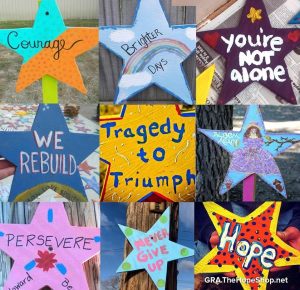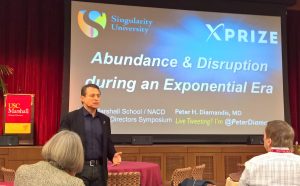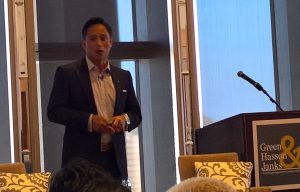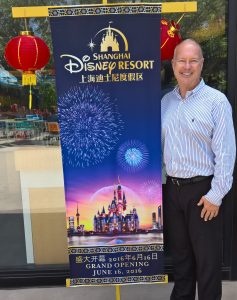 When a group of CSR and Employee Engagement leaders from many of the world’s most admired companies come together for one purpose, that of engaging employees to make a positive impact on the world, magic happens. This is what happened last week at the Points of Light Corporate Service Council (CSC) meeting. This annual convening was hosted at the Deloitte University (DU) outside of Dallas, Texas.
When a group of CSR and Employee Engagement leaders from many of the world’s most admired companies come together for one purpose, that of engaging employees to make a positive impact on the world, magic happens. This is what happened last week at the Points of Light Corporate Service Council (CSC) meeting. This annual convening was hosted at the Deloitte University (DU) outside of Dallas, Texas.
This year’s theme was Aligning with Values: Strategies and Investments in Values-Based Leadership. Some of the take-a-ways: 1. Create an ERG (employee resource group) for volunteering/service. A grass roots approach to exponentially expanding employee volunteering. Two companies there are doing it with great success. First I have heard of this. 2. Company contributes $100 to employee’s healthcare reimbursement account based on their volunteering.
This is a long article and if time challenged, and who isn’t, you can pull what is relevant from the topics: Trust in Crisis, Thoughts from the C-Suite, Leading with Values in a Changing World, Asia, and Redefining Models for success.
The meeting kicked off with greetings from Points of Light Board Chair Neil Bush talking the importance of the public-private partnerships that come out of the Corporation for National and Community Service and with it AmeriCorps. As CNCS is on the cut list of the U.S. Federal Budget, Neil said, “AmeriCorps plays a special role, especially in this moment, and the critical importance it plays with our corporate work.” A discussion was held later in the day on how companies can help to lead their voice to the #SaveAmeriCorps campaign.
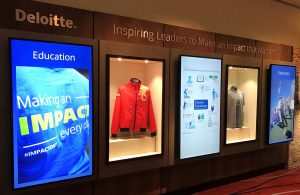 We were officially welcomed to Deloitte by the POL CSC Chair, and Principal, Policy, Government Relations and Corporate Citizenship for Deloitte, David Williams. He said enthusiastically, “Points of Light is the most important organization to create changemakers in the world.” He talked about DU being a place to make better leaders through courage, service and learning. He called the place “Our House.” It’s a place where Deloitte employees can come together, collaborate and meet people they might not normally meet.
We were officially welcomed to Deloitte by the POL CSC Chair, and Principal, Policy, Government Relations and Corporate Citizenship for Deloitte, David Williams. He said enthusiastically, “Points of Light is the most important organization to create changemakers in the world.” He talked about DU being a place to make better leaders through courage, service and learning. He called the place “Our House.” It’s a place where Deloitte employees can come together, collaborate and meet people they might not normally meet.
Jenny Lawson, President of Networks at Points of Light, and longtime leader of the CSC, acted as the host of the day and half meeting. In a succinct and poignant way she kicked off the meeting with “I’d rather not talk about it, let’s try it. This is a place to think about our work together and go forward to make it happen.”
Trust in Crisis
Many of you have read, and seen presentations of the annual Edelman Trust Barometer (this is the report’s 17th year). For those of you who have already seen the 2017 report, you were probably as horrified as I was to read how quickly sentiment has shifted. Steve Behm, President of Edelman South, brought the report to life with an infusion of Edelman’s Earned Brand work in a way that I have not seen before. “Trust in institutions is in crisis. Trust in Governments, NGOs and Business have all gone down. The trust gap is widening. There has been a fundamental shift from the old model of doing things ‘for people’ to the new model of ‘with people.’ License to operate is at risk.”
Steve discussed their methodology of looking at the Informed Population and the Mass Population. The informed population is made up of four criteria: Ages 25 to 64, college educated, in top 25% of household income in each country, and report significant media consumption and engagement in business news. They make up 13% of the total global population. The Mass Population is all others making up 87%. The mass population is feeling left behind and is rejecting established authority. This is what was behind Brexit, the November U.S. Election and what we are seeing in various countries of Europe and to a certain extend even in China.
Business still have an opportunity to restore trust. Where the system is failing, companies are expected to do more. Treat employees better, listen to customers, pay their fair share of taxes, have ethical business practices. Businesses are expected to lead. To do things differently. There is work to do. This latest survey shows that only 37% view CEOs as credible, but this is better than the 29% credibility of government officials. The brand research shows 62% will not buy if a brand fails to meet societal obligations. 60% of doing good should be part of a brand’s DNA. 55% think brands can do more to solve social ills than government. Hard to believe but many view brands as more powerful than government and that brand obligations extend to society at large. Millennials are more likely to take action on behalf of a brand. Purpose drives consumers. Demonstrate a belief system. Invite customers to create shared action.
The informed population is more forgiving and has a better understanding of long term integrity when one off hiccups occur. The Mass Population is more reactive based on limited information. Regardless of the accuracy of the situation, social media can make a small issue a huge story. It is important that companies react quickly and publicly. “This is not how we act, This is how we act. And when there is a problem, own it, state that it will be fixed and solved.”
One slide titled “Do Things Differently” offered this suggestion on how to think about what companies can do when systems are failing, or the perception that they are: “Identify the business need; Assess need relative to economic and societal fears; Learn without bias; Provide context; Engage openly; act and advocate.”
Steve ended on a positive approach with a people centric model. He then offered this provocative quote from Winston Churchill: “If you are going through hell, keep going!” How else are you going to get through it?
Thought from the C-Suite on the Future of Corporate Social Leadership
Two company executives shared a bit about their company’s CSR work, but really focused on the employee and society. Southwest Airlines formed a social topics council made up of representatives from Legal, Diversity & Inclusion, Communications, HR, Marketing on how to tackle looking at various stakeholders to drive decisions that are more thoughtful. Tata Consultancy Services Chanel filled the need for their employees to stand up and express themselves through volunteering and being engaged in the community. They also, provided a mashup of Twitter, Facebook, LinkedIn to express emotions that was moderated and curated.
Leading with Values in a Changing Wo
“The promise and possibilities of investment in social challenges scaled through corporate-led collaborations is a movement whose momentum is growing.” This was a two hour session that began with Points of Light Chief Programs Officer Malikah Berry talking about Resilient Communities. She said, “neighborhoods exist amid complex challenges. Clicktivism, Activism and Volunteerism… There are greater avenues for neighbors to lead neighborhood change.” Resilient Communities is a POL program that will create healthy, vibrant, thriving places of opportunity for everyone. Social Determinants of Health and Rockefeller Resilient Cities methodology determined four domains of resiliency: Neighborhood/Built Environment, Economic Stability, Education and Health. Points of Light’s program is based on this framework.
The Rockefellor and Monitor Institute, a part of Deloitte Consulting LLP, have created “PARTICIPATE: The power of involving business in social impact networks”—a handbook for social change leaders aspiring to effectively engage the private sector as authentic participants in the pursuit of social impact.
Social Impact and Business Value. “Wicked problems are growing in complexity and size. Problems which cannot effectively be tackled in isolation,” said Anna Muoio, Specialist Leader at the Monitor Institute. “Wicked problems themselves are hard to identify. Networks enable large groups to drive systematic impact. Set broader ambitions, diversify risk, spur smart, coordinated plans. It’s important to align solutions within individual communities and they are all different.”
ServiceWorks
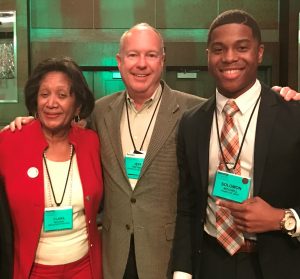 Dinner was shared with a group of amazing AmeriCorps VISTAs and the young people they work with from Education is Freedom. Our VISTA, Clara McDade was inspirational and at 75 an avid volunteer. Our student was Solomon Mitchell, a high school senior bound for a career in fashion merchandise. ServiceWorks is a points of Light program supported by Citi and powered by AmeriCorps..
Dinner was shared with a group of amazing AmeriCorps VISTAs and the young people they work with from Education is Freedom. Our VISTA, Clara McDade was inspirational and at 75 an avid volunteer. Our student was Solomon Mitchell, a high school senior bound for a career in fashion merchandise. ServiceWorks is a points of Light program supported by Citi and powered by AmeriCorps..
What’s Working: Effective Employee Volunteering in Asia
A Framework for Corporate Leaders: “Across Asia, the public increasingly believes that doing good should be part of a brand’s DNA. Regional leaders are also aware that employees are more motivated to perform when they see their company engaged in societal issues, according to the 2016 Edelman Trust Barometer. Addressing these trends, this report equips corporate volunteer leaders with a framework to build effective employee volunteer programs in Asia, and features examples of what’s working for more than 25 global and regional brands.
RiseUp: Re-Defining Models for Success
Michael Shaun Conaway, CEO of Storyworks talked about his new movie: “We Are Creating A Movement Together: In this movie, with some of the most brilliant, accomplished and high-impact leaders of our day, we will re-define a new model of success to uplift and empower people to live radically fulfilled, purpose driven lives. It’s time for us all to RiseUP.”
Michael also talked about the work that Storyworks does for companies around The Moral Development of Corporate Culture. He outlined five stages, or levels: #5 Lie, Cheat, Steal. #4 Whatever it takes. #3 Do no harm. #2 Net positive. #1 Problem solvers. He said most of the companies in the room are either #2 or #1s. Actions are aligned with the company’s purpose and values. “Do good and do well. Tell your story!”
24 Hours of Inspiration and Engagement
The time spent together at this year’s Points of Light Corporate Service Council was thought provoking, inspirational and an opportunity for peers to share thoughts and insights on who we can help our companies, and our employees make a more impactful difference on society.
http://www.edelman.com/global-results/
https://www.rockefellerfoundation.org/report/participate-the-power-of-involving-business-in-social-impact-networks/
http://www.pointsoflight.org/corporate-institute/resources
http://riseupthemovie.com/
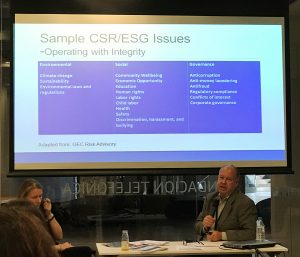 It is interesting to note that as companies move to more closely align their employee volunteer programs with their corporate social responsibility (CSR) strategy, employees are seeking more fulfillment and purpose in their lives, which sometimes take them in a different direction from their employer. CSR and employee volunteering are not mutually exclusive and both are gaining traction for different reasons.
It is interesting to note that as companies move to more closely align their employee volunteer programs with their corporate social responsibility (CSR) strategy, employees are seeking more fulfillment and purpose in their lives, which sometimes take them in a different direction from their employer. CSR and employee volunteering are not mutually exclusive and both are gaining traction for different reasons.




